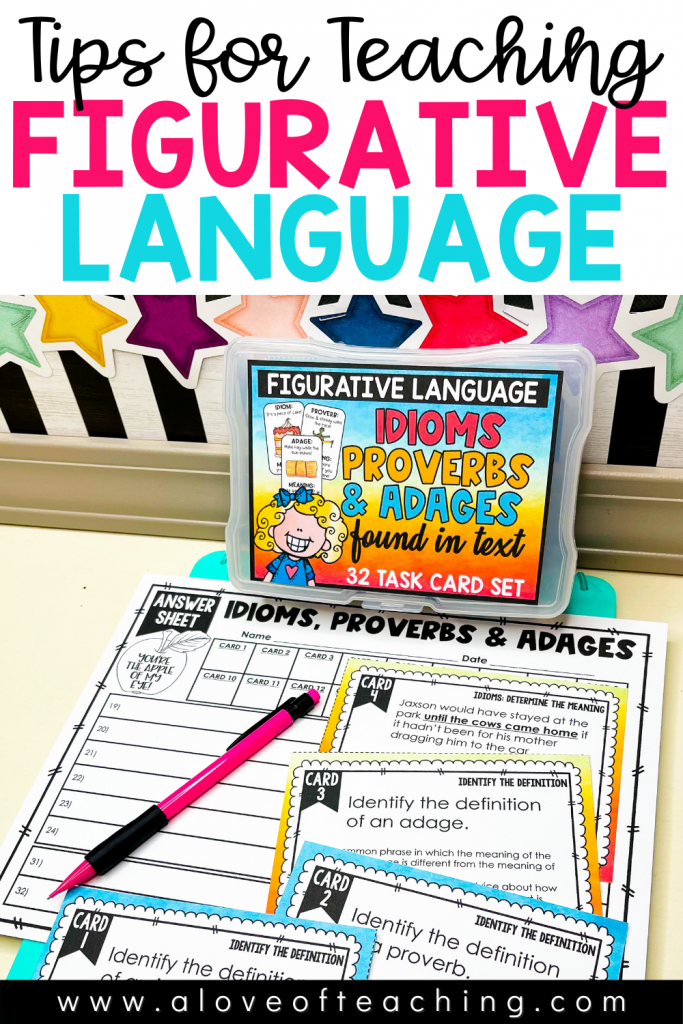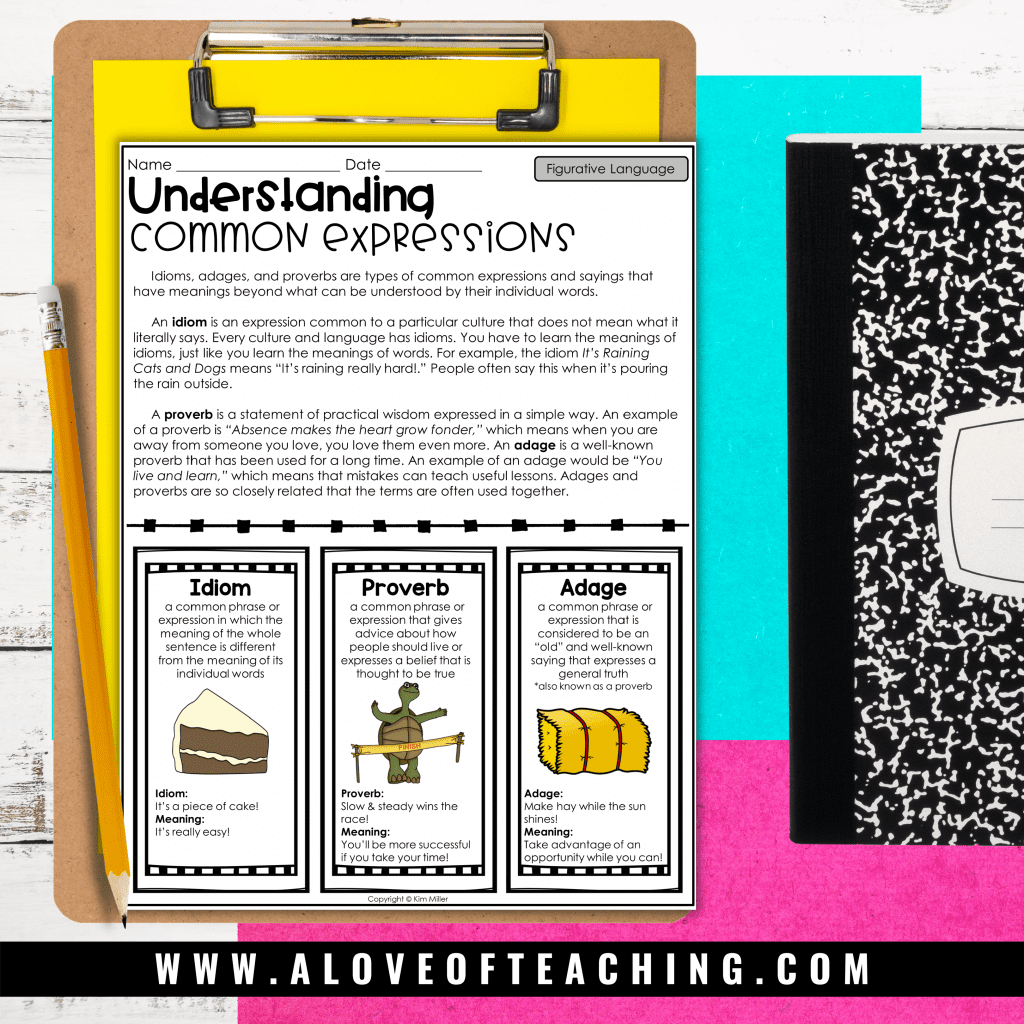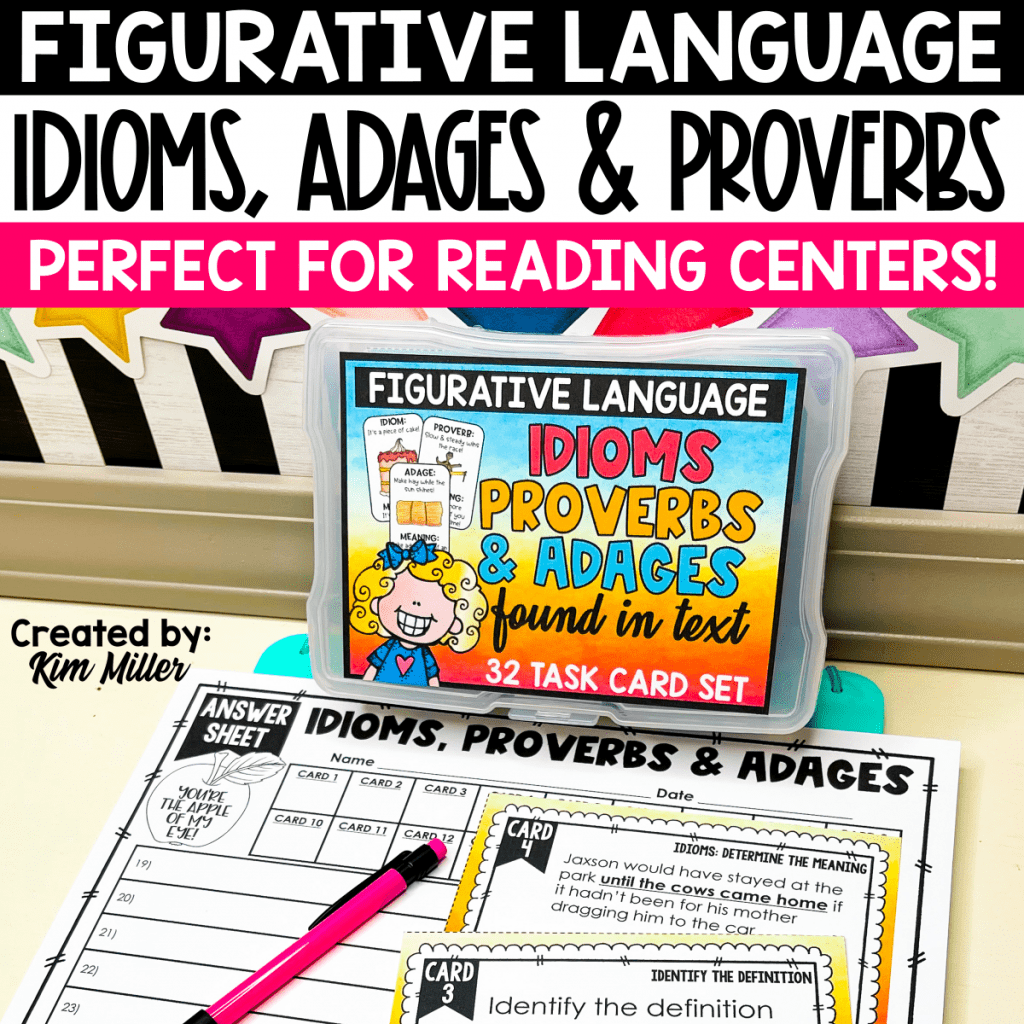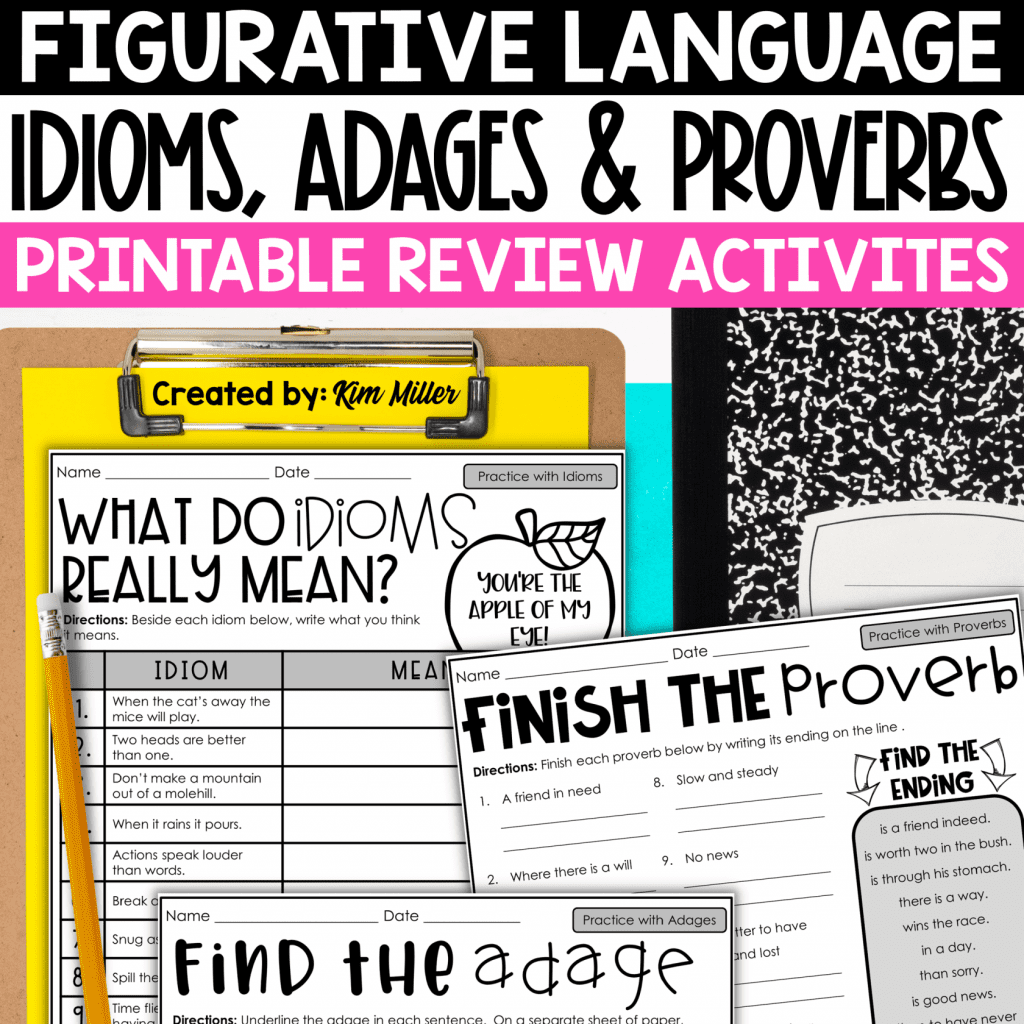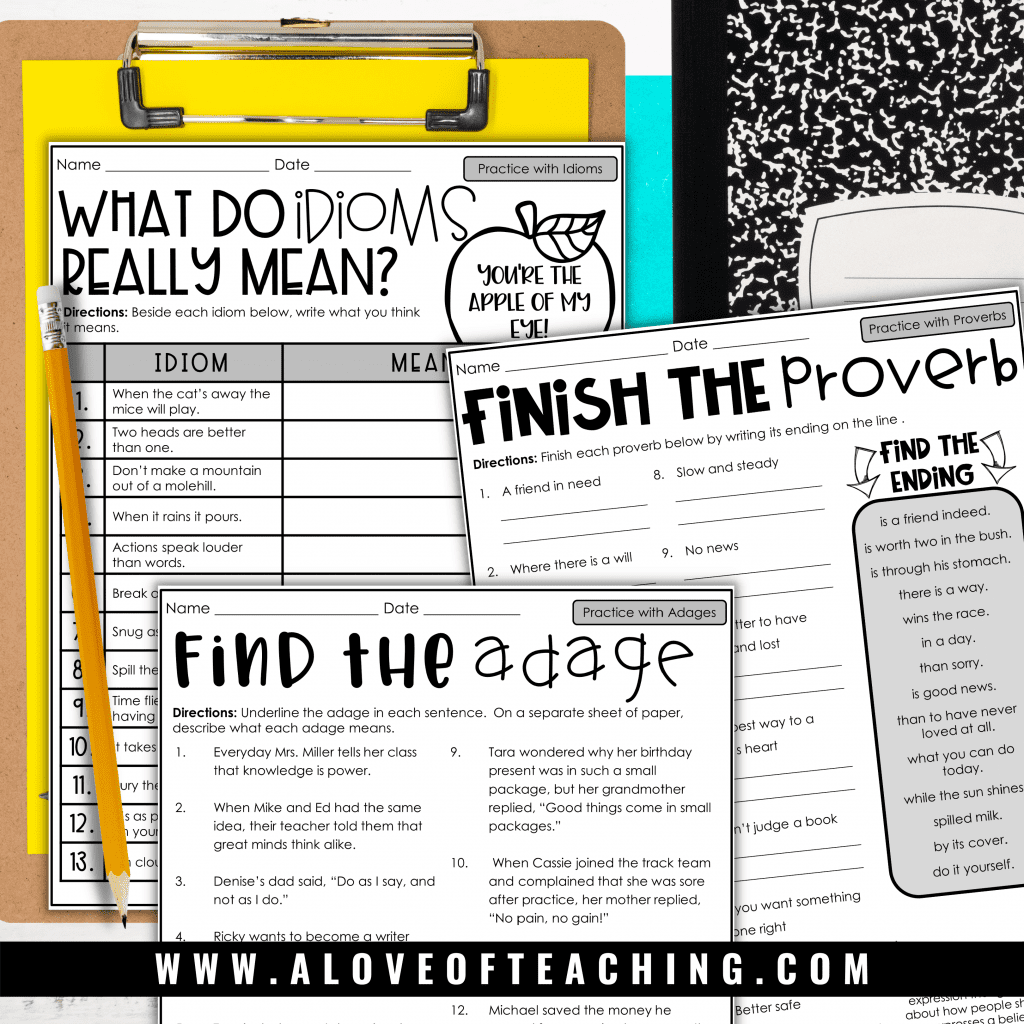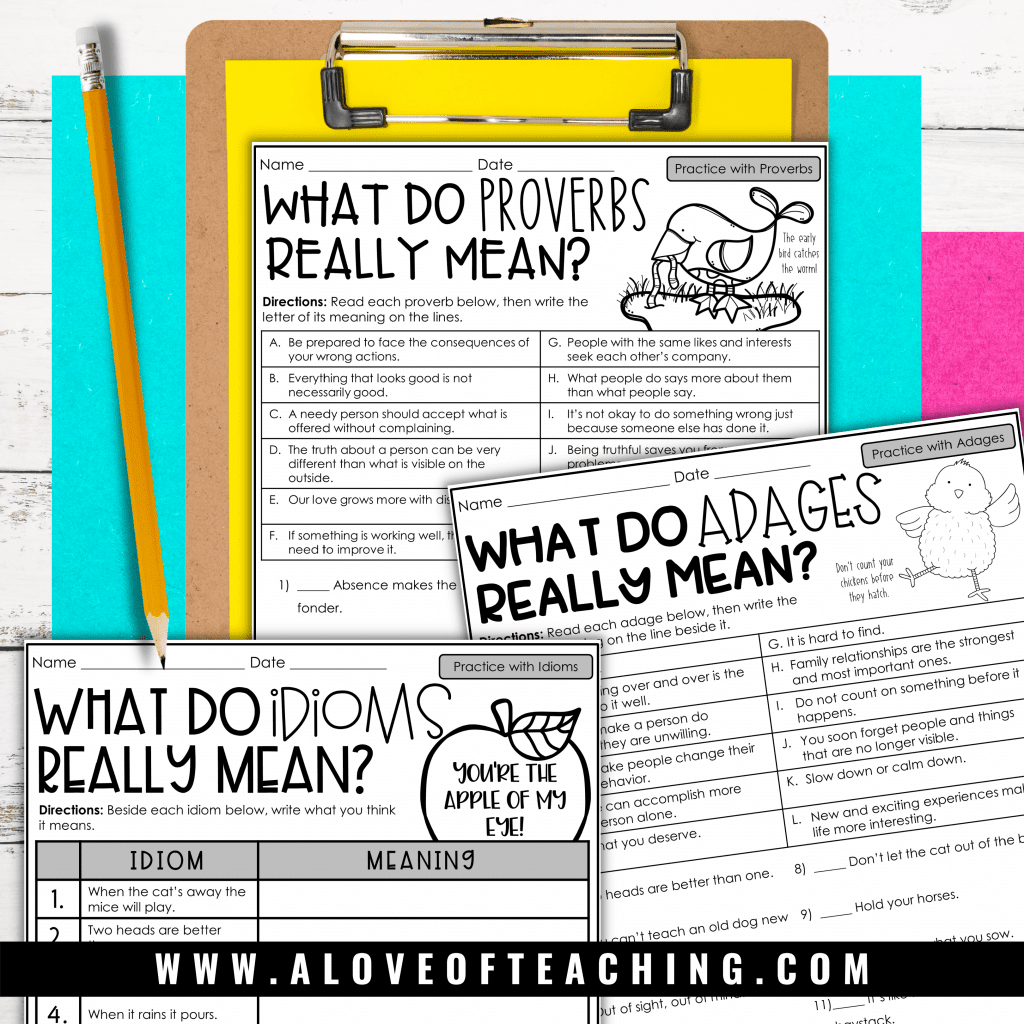Teaching Figurative Language
Does the thought of teaching figurative language make you feel as sick as a dog? Teaching figurative language like idioms, adages, and proverbs can be daunting if you don’t have a plan in place before you get started. Using figurative language in everyday conversations is something we as adults take for granted, but our young learners haven’t acquired the skills necessary to use idioms, adages, and proverbs correctly just yet.

I have always loved weaving idioms, adages, and proverbs into my everyday conversations with my students. They are fun to use and can be a great attention getter for students. I know it can be difficult to unpack the parts of figurative language in ways your students will understand let alone have fun learning. I am here to help simplify the process of teaching figurative language with strategies you can use all year long. We all know the proverb, “A friend in need is a friend indeed!”, and I’m here for you my friends! I am so excited to share my tips and tricks for teaching figurative language with you.
Why Teach Figurative Language?

Teaching figurative language is so important for our student’s language development. In our society, figurative language is all around us. Our students must be able to determine what is literal and what is figurative in their reading and listening. Children who are able to understand figurative language have better overall reading comprehension and are better able to understand abstract ideas, interpret text and analyze the meaning of that text. These are beneficial skills your students will be using throughout the rest of their academic careers. Figurative Language also helps students communicate their thoughts and understanding in a more eloquent manner.
For our English Language Learning students, understanding figurative language is vitally important. Since the use of figurative language is not common in all cultures many of our non-native English speakers will struggle with understanding figurative language. It is important that we teach them these concepts so that they are able to move past the literal translation of everything they read and hear. Additionally, as our ELL students are able to begin using figurative language their overall language skills and fluency increase.
Figurative language affects all areas of our students’ language usage: reading, writing, and listening. For all of our students, building these foundations now will be the key to their future language success.
Types of figurative language
While there are many types of figurative language, today we will be focusing on the three I feel are the easiest to start with, idioms, adages, and proverbs. Let’s take a minute to review each of the three types and a few hints on how to teach them.

Idioms
An idiom is an expression common to a particular culture that expresses a thought or action in a non-literal way. Here are a few that I’m sure you’ve heard: “Good things come to those that wait.”; “Better late than never.”; and one of my favorites, “As snug as a bug in a rug”.
Students will have an easier time learning idioms if they are presented in a way for students to remember their meanings just like they would if they were learning the meaning of a new word.
Visual imagery is also really important when teaching idioms, so any opportunity you have to let your students draw what the idiom would look like will help them retain their learning. I like to have my students draw two pictures. The first one is a literal meaning and the second picture is the real meaning. This helps them see just how absurd the literal meaning is in many idioms.

Adage
An adage is a phrase that expresses a truth or known fact in a simple way. An adage is a statement of truth but it doesn’t give advice or tell you what to do. That’s the key that makes it different from a proverb. I remind my students that an adage can be used when they are making an observation.
Here are some more adages that I’m sure you’ve heard: “The early bird gets the worm.”; “Birds of a feather flock together.”; and “Opposites Attract.” These are all statements of fact that have a literal and a figurative meaning.
When teaching adages I like to have my students start first with the literal meaning. We then take that to determine what the adage might be as applied to humans and life.

Proverb
A proverb is very similar to an adage so it’s easy to confuse the two. A proverb, however, is a common phrase that gives advice. I ask my students to visualize a wise, old person giving them advice like, “Don’t judge a book by its cover.” or “Where there’s a will, there’s a way.” A proverb is a simple way to give advice in a way that is easy to remember.
While figurative language is often something saved for the spring semester when poetry is taught, I prefer to teach it at the beginning of the year. We might not dive in deep at that time, but a basic introduction and a little practice are perfect. Once this foundation is laid, I can refer back to that learning all.year.long! I love to review different types of figurative language as they naturally appear in our read alouds, textbooks, videos, and more. By reinforcing the teaching in this authentic way, students make quick connections that help them remember.
With a few easy-to-use, no-prep activities, you will be ready to teach these important language skills whenever you need to. I have pulled together all of my favorite Figurative Language teaching tools into one place and I’m excited to share them with you.
How I Teach Figurative Language
Prior knowledge
I have found that it’s helpful to know where my students are starting, their baseline knowledge. I like to use worksheets from the figurative language practice pack as a pre-assessment. Not for a grade, but for me! Students will identify idioms, adages, and proverbs in different ways. Based on their answers, I can assess what my students already know and what they still need to learn. This allows me to be very intentional with my lesson planning.
The students love taking pre-assessments. Any time we complete one I remind them that they are helping me teach them better. I let them know that I don’t want to waste their time teaching them something they already know. This is something they always appreciate.
Later in the year, we may complete the same worksheet again. This time it will be done as part of the lesson or as a post-assessment. Sometimes I even save the pre-assessment and give them back to students later so they can see just how much they have learned.
Engage, Engage, Engage!
When it comes to difficult concepts, I find that the more I can hook my students from the beginning the easier the learning. While some students will immediately recognize figurative language, others may have never heard of idioms, adages, and proverbs before. If you have English Language Learners in your classroom, these concepts are likely going to sound very strange to them. Using a hands-on or visual activity to introduce figurative language is a great way to engage students.

When it is time to introduce figurative language there are so many fun and creative things you can do. Here are some ways I have introduced idioms, adages, and proverbs to my class that has provided rich learning opportunities:
- Hanging printed images of cats and dogs from paper clouds on the ceiling of the classroom (It’s raining cats and dogs)
- Give all students who arrive to class early a gummy worm (The early bird catches the worm.)
- Put a pile of shredded paper in the middle of the room with a small printed image of a needle hidden inside for students to find (A needle in a haystack)
These are all great visual representations of idioms, adages, and proverbs that really hook my students and get them excited about learning the ins and outs of figurative language.
Let Them Talk!

On the days that I use these engagement hooks, I fight every urge I have to jump right into the lesson. Wait – it will be worth it! By giving students the time they need to think, brainstorm, and discuss ideas with their peers, they will be more excited about the learning to come. I love discussion time because it gives students the opportunity to share ideas, challenge thoughts in a constructive way, and work on important collaboration skills.
By the time we get to the actual lesson, students have already spent a lot of brainpower engaging with the topic. With a little guidance and creative thinking, your students will be able to come up with the correct form of figurative language represented by the visual example you have on display. I love seeing those lightbulbs go off when they make the connection. After that, the flood gates are thrown open. Students will be eager share to all of the idioms, adages, and proverbs they know. You can almost feel the energy and excitement in the room during this important process.
The Power of Peers
Once we have learned about figurative language it’s time for some practice. Group work is so important in my classroom because it naturally lends itself to collaboration. Allowing students the time to collaborate with their peers helps them to learn and grow from each other. Sometimes we, as teachers, need to remember that we aren’t the only people in the classroom who have the knowledge to share.
Group work time is the perfect opportunity for me to use the figurative language task cards. Task cards are an easy activity that can be completed with small groups or partners. They also make a classroom scavenger hunt or a game of Scoot easy to do.
And . . . differentiation is easy as pie with 32 different cards to choose from. I can assign a few or all of the cards based on the ability level of the group. I love using task cards with my class! They are so versatile and can be pulled out throughout the year to use as a review activity, early finisher activity, or homework.
These Figurative Language Task card activities include:
- Identifying the definition with multiple choice answers
- Determine the meaning with multiple choice answers
- Describe the meaning using open-ended questions
- Write sentences using idioms, adages, and proverbs that describe their meanings
These colorful task cards can be printed and laminated for durability. Keep them in a repurposed pencil case, baby wipe container, or shoebox for easy access throughout the year.
Practice Makes Perfect
Throughout the year, I use my figurative language printable worksheets as much as possible for idiom, adage, and proverb review. Not only is it an easy way to get in some figurative language practice, but it’s also an easy way for me to monitor their progress throughout the school year.
Make an easy language arts center by putting the printed worksheets in page protectors. Add a dry erase marker and voila! – a ready-to-use and reuse center.
These worksheets are perfect for:
- desk work
- morning work
- small groups
- early finishers
- reading centers
- homework
- intervention
Teaching Figurative Language Is A Piece Of Cake!
Using figurative language task cards and worksheets will make teaching these sometimes confusing language concepts not only easy but fun and exciting too! With activities you can use all year long, teaching figurative language can be an active and important part of your language arts curriculum and not just a side lesson with poetry. I know you and your students will love these activities as much as my students and I do.
Save These Ideas for Teaching Figurative Language
Don’t let the thought of teaching figurative language cause you to lose your head. Instead, pin this to your favorite classroom Pinterest board and come back when you need more fun and engaging teaching for idioms, adages, proverbs, and other important skills and concepts.
